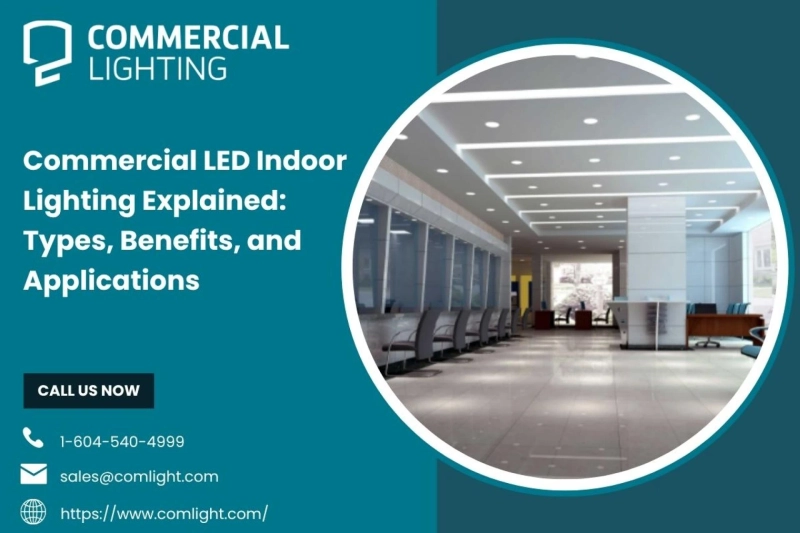When we talk about commercial led indoor lighting, it has moved from a simple retrofit idea to a core building system that drives energy performance, comfort, and safety. LEDs are the most efficient of all the lighting technologies, and hence, they have the longest service life of the other three (legacy) technologies. The Department of Energy sees the extensive use of LEDs as a major energy-saving initiative for the whole country and adds that LEDs are generally much more electrically efficient than incandescent or fluorescent lamps, although their lifetimes are in combination of order. ENERGY STAR informs that lighting is one of the major consumers of electric power in the commercial sector, thus, the effect of the operation is immediate when the fixtures are changed.
What qualifies as commercial LED indoor lighting?
This specification includes the LED light sources that are designed for long-term regular use in offices, schools, hospitals, hotels, and stores. LEDs direct the light in a very precise way, which lowers the losses within the luminaire and enables the user to get the best light distribution for such activities as reading, filing, and movement.
That directional output helps recessed downlights, panels, and troffers deliver uniform illuminance with lower wattage than older technologies.
Core fixture types and where they fit
1. Troffers and flat panels
T‑grid troffers and thin panels integrate with suspended ceilings to produce even ambient light across workstations and corridors. Common options include multiple size formats (1x4, 2x2, 2x4) along with selectable lumen settings and 0 to 10 volt dimming for controls integration. Typical ranges span roughly two to seven thousand lumens and color temperatures near 3500 K to 5000 K.
2. Linear luminaires
Suspended or recessed linear bars shape long ribbons of light for open offices, classrooms, and collaboration zones. Many models offer adjustable output packages, varied mounting methods, and high-rated life values, which support flexible layouts and future reconfiguration.
3. Downlights and retrofit modules
Round or square recessed units focus vertical light for lobbies, aisles, and task areas. Retrofit kits simplify upgrades from older CFL cans and often provide wide beam distributions, high efficiency drivers, and life ratings of around fifty thousand hours or more.
Across these families, you will see standard features such as 120 to 277 volt operation, damp location listings, and simple mounting hardware that reduces labor time during installation.
Why LEDs deliver consistent value in commercial spaces
1. Lower energy and utility costs
DOE guidance shows LEDs consume at least seventy-five percent less energy than incandescent lighting, with directional optics that cut losses compared with diffuse sources. ENERGY STAR highlights that businesses benefit quickly because lighting typically runs for long hours.
2. Long service life and reduced maintenance
Industry practice uses L70 or L90 ratings to describe the hours until output declines to specified thresholds. Many indoor commercial products specify fifty to eighty four thousand hours, which translates to fewer relamps and lower disruption for occupied spaces.
3. Better thermal behavior and comfort
LEDs release little heat compared with traditional lamps, which helps stabilize room conditions and reduces unnecessary cooling load around ceilings and plenum spaces.
4. Controls synergy
Networked or local dimming, occupancy sensors, and daylight-responsive strategies can push savings further. A meta-analysis of real buildings found average lighting energy reductions of about twenty four percent from occupancy control, twenty-eight percent from daylighting, and up to thirty-eight percent when strategies are combined. DLC resources show how networked controls and luminaire-level approaches coordinate sensing at each fixture for deeper, measurable reductions.
Matching applications to light levels
Choosing fixture types is only half the job. Target illuminance should align with the tasks in each room.
- Open office work surfaces often require around thirty to fifty footcandles at desk height.
- Conference tables tend to sit near thirty footcandles with separate vertical light for whiteboards.
- Corridors and circulation paths typically run near five to twenty-five footcandles, depending on activity.
- Retail ambient levels more commonly start around forty to fifty footcandles, with accent light several times higher on displays.
These values trace back to IES recommended practices and quick reference guides used by designers and energy programs, and they help avoid overlighting.
Practical selection tips for teams and facility managers
- Identify priority tasks in each zone, then select distributions (uplight, volumetric, narrow, batwing) that fit those tasks. Use IES targets to prevent overlighting.
- Specify dimming compatibility (often 0 to 10 volts) and plan sensor placement and commissioning so controls behave predictably for occupants.
- Confirm DLC listings where rebates require them, and store product QPL references with submittals.
- Document rated life and lumen maintenance along with warranty terms, since these factors drive the total cost of ownership.
Final word and next steps
Should you be considering commercial LED indoor lighting for a refurbishment or a new construction, it would be wise firstly to create a brief plan of your areas and their functions, and then decide fixture optics, control strategies, and target illuminance accordingly. Such a systematized method of work usually defeats a mere wattage change and thus enables you to realize the savings very fast. In case you require a brief checklist customized to your layout, just send details of your building type, ceiling heights, and operating hours. We will prepare a sample package and a control strategy for you to take to the best lighting supplier in your area for pricing and implementation.



